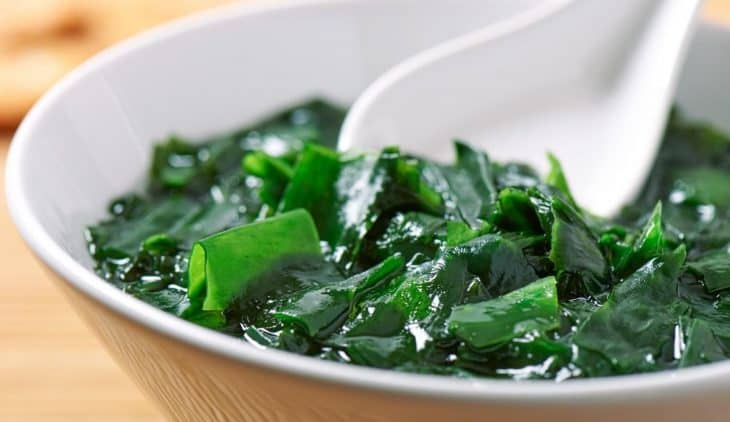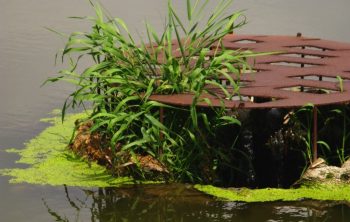What is the difference between kelp vs seaweed? And why are they used as fertilizer? Isn’t kelp seaweed? What form should I pick (seaweed powder or liquid extract)? I ask myself all those questions when I look at the different organic and/or natural fertilizers available in the gardening market.
I’ll try to answer all those questions in the next lines in the hopes you may choose better about kelp and seaweed with information on your side.
Kelp vs Seaweed – Is There Any Difference?
Seaweed is a word used to name many species of aquatic plants, specifically oceanic ones (hence the sea- prefix). Seaweeds can grow like underwater forests, kelp beds (a type of brown seaweed) cover up to 25% of the world’s coastlines. Seaweeds create ecosystems that can host thousands of other sea creatures such as plankton, seals, fish, jellyfish, and more. Phytoplankton is also considered seaweed because of its immense growth potential.

Seaweed is a term that includes many types of algae, including kelp. Seaweeds grow in many marine environments (oceans, rivers, or lakes), but especially kelp, grows in shallow and cool saltwater along rocky coastlines.
Some of these seaweeds are even called sea vegetables because they’re edible to humans. For example, nori algae (used by the Japanese in sushi and other traditional dishes), dulse, kombu, and wakame. Some seaweeds are medicinal and used mostly to treat skin problems. For more info on seaweeds and kelp, click here to open the National Ocean Service.
|
Seaweed |
Kelp |
| Include many types of algae red, brown, and green. | Brown type of seaweed |
| Grown in many marine environments | Only grows in saltwater, along rocky coastlines in depts of 6 to 90 ft. deep |
| Many different sizes, some of which are microscopic | Large size |
| Used as a liquid fertilizer from natural seaweed sources | Used as a natural fertilizer and source of trace minerals and usually mixed with fish meal |
| Can be found in powder or liquid kelp |
GS Plant Foods Organic Liquid Kelp Fertilizer
Kelp as a Garden Fertilizer
But how does kelp or seaweed help my garden
In the garden, kelp and seaweed turned out to be great fertilizers for any kind of plant/soil nutrition deficiencies. Seaweed is not particularly high in nitrogen or phosphorous, but they contain up to 60 different minerals which are micronutrients (trace elements) for plant health promotion. It also has pest-deterring properties. Pets don’t like the smell of it, which results in keeping them away from the garden.
Seaweeds, including kelp, certainly amend nutrient-depleted soils and improves structure, and water retention rates ultimately end up decomposing, and in the process, they add organic matter to your garden beds, pots, composts, or other fermented fertilizers.
Learn more about How To Use Kelp Meal Fertilizer
Neptune’s Harvest Organic Hydrolized Fish and Seaweed Fertilizer
Foraging Seaweed for Fertilizer
If you forage kelp or other seaweeds for fertilizers, follow these tips for better results.
- Collect only from the coastlines below the high tide mark, in small quantities, and only what you need.
- Know that there’s no need to wash the salt away, it contains minerals and nutrients.
- Cut the plants by hand or with grass scissors. Sometimes they hide small stones, sand, or even shells.
- Use fresh or dry, both ways are equally nutritious to the
soil . - Apply over your garden beds, under the mulch, and in your compost.
- If you buy it, it comes available in powder and liquid extracts, and different concentrations. Choose the best suitable for your project. Liquid extract for hydroponic systems seems like a great idea. Seaweed powder is more suitable for growing beds, and pots, and as a compost improver.
For more useful tips and info regarding seaweeds as fertilizers, I recommend the article Seaweed Fertilizer — Using and Composting Seaweed for Your Garden.
Kelp Nutrition Data
When it comes to kelp, you may be wondering what the nutrition data is like. In every two tablespoons of kelp, it contains the following:
- calories: 43
- fat: 1g
- sodium: 233mg
- carbohydrate: 10g
- dietary fiber: 1g
- sugar: 1g
- protein: 2g
The following percentages are how much it’ll be as part of your daily recommended intake:
- vitamin C: 3%
- iron: 17%
- calcium: 13%
- vitamin A: 2%
The following are all 0%: magnesium, vitamin D, vitamin B6, and cobalamin
Nutrition Value of Seaweed
You may also be curious about the nutritional value of seaweed. Every cup of seaweed (which is around 15g), contains the following:
- calories: 45
- fat: 1g
- carbohydrate: 8g
- dietary fiber: 1g
- protein: 5g
The following percentages are how much it’ll be as part of your daily recommended intake:
- folate: 13%
- copper: 56%
- iron: 21%
- riboflavin: 22%
- thiamin: 15%
- magnesium: 17%
All You Need to Know: Kelp
You may be wondering everything you need to know about kelp when it comes to gardening. Let’s take a closer look.
Kelp isn’t usually used on its own as a fertilizer, it’s most often mixed with other ingredients, such as fish, to promote plant growth. Kelp is used because it’s packed full of micronutrients, which make for a great environment for plants to thrive. Kelp fertilizer can usually be found as a liquid or as a powder.
What many gardens love about kelp is that it’s an organic product, that’s packed full of goodness. As well as helping your plants to thrive, it’s also good for the environment.
To use kelp fertilizer, all you need to do is spray it onto the leaves of your plants. Results can be seen fairly quickly; in around a day or two.
All You Need to Know: Seaweed
Now we know all there is to know about kelp, you may be wondering the same for seaweed in gardening. Let’s take a closer look.
To make seaweed fertilizer, the sea water is usually rinsed and then left to ferment with regular water. Over time, the seaweed will decompose and you’ll be left with a fertilizer to use. Seaweed fertilizer most often comes in liquid form.
The benefits of seaweed are much the same as the benefits of kelp. However, as well as this, they can last in extreme environments and are a hardy fertilizer.
To use seaweed fertilizer, simply spread it around your plants – it is that easy!

Health Benefits of Kelp
When it comes to kelp, as well as being good for your plants, it’s also extremely good for your body too! Let’s see some of the health benefits of kelp.
- Sea Kelp is Full of Vitamins. Iron, Magnesium, and Vitamin A – sea kelp is bursting with goodness. This goodness can help to keep your eyes, bones, and even your immune system at its best!
- Helps with Hair Loss. Kelp is known for containing iodine. And iodine is known for aiding with things like hair loss.
- Lower Cholesterol. A study found that kelp can even help your cholesterol levels.
Health Benefits of Seaweed
As well as kelp being good for your body, so is seaweed. Let’s see some of the health benefits seaweed has to offer.
- Contains Iodine. Without iodine, thyroid problems may occur – and seaweed is full of iodine!
- Good for Gut Health. Seaweed can help replenish the good bacteria your gut needs. And a healthy gut is a happy gut.
- Weight Loss Aid. Seaweed can help you feel fuller for longer and doesn’t contain many calories at all.
Conclusion: Kelp vs Seaweed
If you use kelp or any seaweed as fertilizer, there are a few things to consider:
- You may forage it in small quantities, always trimming the submerged parts of the seaweed, and avoid collecting it from the beach.
- Notice that seaweed foraging may be an illegal practice in your region.
If you liked this post about kelp vs seaweed, and find it useful, please share it with your friends and leave your comments below. We love to read your feedback. And remember, sharing is caring!
FAQs
Is kelp the same as seaweed fertilizer?
No, kelp is not seaweed fertilizer. Kelp is a type of alga (one of the plant kingdom) that can be found in salt water.
It is used for various purposes including fertilizer and food. In fact, it’s one of the most popular seafood supplements out there. Kelp is also commonly known as seaweed because of its similarity to the plant life that grows on land. However, kelp has more in common with plants than seaweed.
It is often referred to as “kelp” or “rockweed” since it is so similar to the plant life on land. There are different types of kelp. One of the most common varieties is Alaria esculenta (macroalgae) which is a type of red algae. This variety is the main source of nutrition for people who consume kelp supplements. Another variety of kelp is Laminaria digitata, which is a type of brown algae. These two types of kelp are found in coastal areas. One of the reasons that people use kelp is because it is a natural source of vitamins and minerals. It’s also a great source of iron and iodine. Kelp contains an abundance of vitamins, minerals and proteins.
Is kelp a good fertilizer?
Yes it is a good fertilizer. It is a very good source of nitrogen (N) which is needed by plants. The nitrogen is released as ammonia.
This is then used by the plant for photosynthesis. It is also a good source of potassium (K), magnesium (Mg), calcium (Ca), and phosphorous (P). There are a few problems with kelp though. The biggest problem is that kelp takes a long time to decompose. It can take anywhere from 2 to 10 years. This is because it contains cellulose, which is a natural organic compound.
The cellulose breaks down in soil over time, releasing nutrients. Another problem with kelp is that it tends to build up in rivers and streams.
If you want to use kelp as a fertilizer for your lawn, then it may work well. Kelp contains a lot of nitrogen. However, this nitrogen is locked away inside the plant. You would have to apply the kelp to the soil at least 3 times before the nitrogen gets released into the soil. The other problem is that the kelp is not easy to spread out on the lawn. It needs to be shredded first before it can be applied to the lawn. DKelp is just one more ingredient to add to your fertilizer bag. You should look at what else you can add to your fertilizer to get the most nutrients into your lawn.
Is seaweed the best fertilizer?
Seaweed is the most widely used organic fertilizer. It is used to fertilize the soil, but not the plants. It is used as a source of nitrogen and potassium in the soil. The application rate of seaweed is 1-3% in the soil depending on the type of seaweed. It is very effective for the growth of vegetables because it is rich in potassium and nitrogen, which are very important for plant growth. It is also very effective in controlling the weeds.

Brian is an avid gardener who loves spending time outdoors. He is passionate about using his green thumb to create beautiful, lush gardens for her friends and family. He finds joy in tending to her garden, trimming plants, and cultivating new species. He enjoys to share his knowledge and experience with others with a similar gardening enthusiasm. Brian is a true nature enthusiast and a has true passion for the outdoors.






